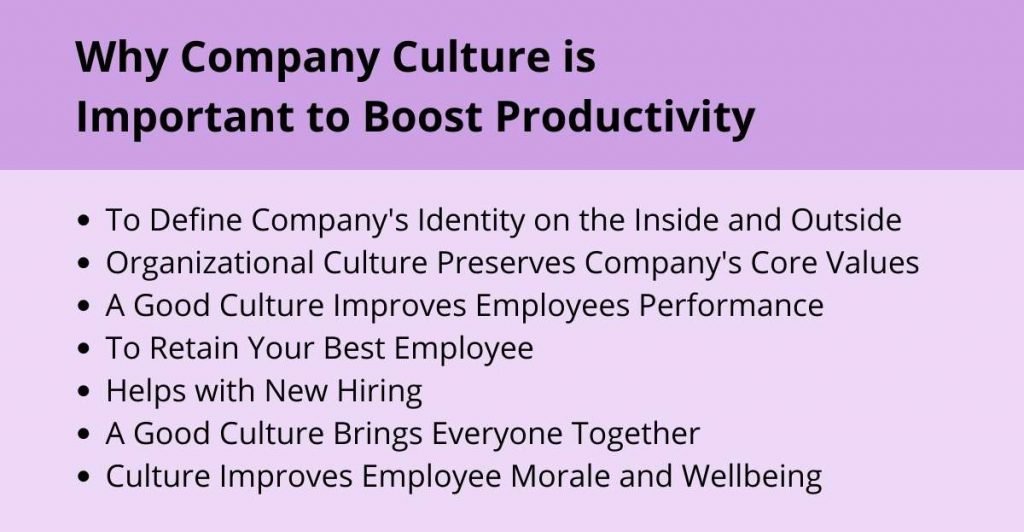An organization should always look for means to boost employee productivity. When employees are more productive, the company will get benefit and grow bigger and better. While various factors affect employee productivity, company culture is crucial to boost employee productivity at the workplace.
In this article, we discuss how organizational culture improves employee productivity, why it is important, and how companies can improve their culture.
What is Company Culture?
Company culture refers to the values, goals, ideas, attitudes, and ideals of a company. Your team’s intangible capabilities determine the way your company conducts business and how it operates. Culture plays a significant role in defining your organization’s identity, which is why getting it right is so important.
Every organization has different goals and has people from different backgrounds, so the two company cultures will never be the same. It is crucial that all employees feel represented and counted for when it comes to creating a positive workplace culture. It would help if you had a corporate culture that unites your employees and motivates them to reach a common goal.
Company culture comes from the following assumptions at the deepest level:
- It is in our nature as humans. Each individual has a different habit. The interaction between employees, customers, and suppliers is based on these assumptions.
- Relationship between an organization and its environment. Who are the organization’s stakeholders, and how does it define its business?
- The right emotions. Can we encourage people to express their emotions while suppressing others?
- How can we determine if the organization and its constituents are doing well? Business strategy and a structure that can adapt to the company’s culture are both crucial to establishing a successful organization.
Why Company Culture Is Important to Boost Productivity: 7 Reasons

To Define Company’s Identity on the Inside and Outside
An organization’s culture defines how they conduct business, interact with each other, and interact with customers, employees, partners, suppliers, the media, and stakeholders.
Because it represents how you do business, an organization’s culture will affect all parts of the business. It is both a part of your identity and your image. Thus your company culture affects how your customers and others view you.
Work-life balance is important for your company, and it would help if you took a moment to consider why each attribute matters to your organization. Furthermore, you should also know in what way do your people and customers value these cultural attributes?
Organizational Culture Preserves Company’s Core Values
Your company’s culture will reflect its core values. Every part of the experience matters; everything from how you conduct business to how you manage workflow to how you interact with colleagues and treat your customers reflects who you are as an organization. Simply put, culture is all about how you act according to your beliefs.
However, if your values are incompatible with your culture, that poses a problem. You may turn out to have a bunch of meaningless buzzwords as your “core values.” Your employees are aware of this.
A strong organizational culture can keep the company’s core values at the forefront of the day-to-day operations and structure. Those values are invaluable.
A Good Culture Improves Employees Performance
Would you believe me when I say organizational culture has the power to transform employees into champions?
Employees perform after knowing that they matter. For this reason, employers should have a nice company culture to make employees feel like their work matters. Employees should keep in mind that their growth and the company’s growth come before just a steady monthly paycheck.
When you can influence your employees, they will promote and preserve your organization’s culture. What is the best way to accomplish this? Recognizing good performance and rewarding the performer will encourage all your employers to perform their best at work.
Cultures that honor individual and team achievements and give credit where it is due to inspire a sense of accomplishment. It is one of the ways to boost employees’ energy and productivity.
To Retain Your Best Employee
It’s not surprising that employees who feel like they belong to your company’s community rather than just being cogs in your company’s wheel will remain with you longer. Many job seekers look for that in a company as well.
Human resources and senior management are encouraged to receive feedback in positive work culture. Team members should not feel intimidated or retaliated against for expressing their concerns or opinions. Corporate employees, however, must understand the proper protocol and procedure for providing feedback.
The top performer at your company is more likely to say that the factor that keeps them focused and encouraged to perform their best is the people and good company attributes. Providing a better work environment improves employee engagement, delivers a unique employee experience, and makes your people feel more connected.
Helps with New Hiring
Your company’s culture can serve as a driving force for employer and employee alignment. Particularly with new hires, they generally take some time to think about the kind of culture they will enter. Even though a company is offering a good salary, a newcomer will think twice before enrolling if they hear about bad company culture from somewhere.
Related Posts
Onboarding is an important time to establish your company’s culture, as it is a guiding force for your employees. Additionally, it can serve as a method of aligning your employees with your mission.
It can be a poor fit, a poor delivery, or a failure to adapt to changes down the road that cause new employees to fail in their new jobs. Employers should align the organization around the need for their new employees and acquire them in the right way with a good culture. Your onboarding program should accommodate the employee’s needs, assimilate them into the organization and accelerate their progress.
A Good Culture Brings Everyone Together
Having a successful organizational culture that unites your people to keep them aligned is key to success. Diverse perspectives can come together with a common purpose behind a culture that is clearly defined. In your organization, there are certain expectations about what people should do and work together.
As part of a culture, teams are meant to bridge the gaps between themselves, guide decisions, and improve workflow in general. A toxic organizational culture, on the other hand, can lead to the opposite outcome.
Culture Improves Employee Morale and Wellbeing
Studies indicate that your organization’s culture plays a direct role in the performance and, more importantly, employee satisfaction. A healthy culture finds a balance between both of these areas based on the values of the organization.
Do you feel that your mental and physical health is overlooked at work because the focus is on performance? Most of the time that will negatively impact your business, and there may be occasions where that isn’t an issue.
By implementing employee wellbeing strategies in the right way for the right reasons at the right time, employers and employees can benefit greatly. They must be developed in a manner consistent with a culture that encourages their success.
Employee satisfaction hinges on supportive management behavior, flexible work arrangements, and an open workplace culture that promotes employee participation.
What are the Best Ways to Improve Organizational Culture?
Having a strong corporate culture affects both the employees of a company and the entire business. Developing and maintaining workplace cultures involves time and energy. Culture matters for various reasons, including employee retention and the creation of a healthier work-life balance.
Here are some ways that employers can encourage at the workplace to have a better organizational culture:
Good Communication
Having good communication skills is essential to improving organizational culture. Miscommunication is one of the main reasons people stop being satisfied with their jobs and start looking for other employment possibilities. By doing your part to ensure good communication, you will provide a better experience for your team.
If you are sending emails or taking part in meetings, make sure that your ideas are as clear as possible. People sometimes need background information or examples to understand an issue better. Find ways to simplify your message when people seem confused.
When employees communicate with each other nicely, they will feel more comfortable while working. They can discuss some important matters and can even ask for help in some projects. Having good friends at workspace boots work productivity naturally.
Discussing Concerns and Ideas
Employers or those in a leadership authority must always be open to employees’ queries and complaints. Also, holding discussions on project management ideas and job-related ideas encourages employees. Therefore, giving your employees a platform where they can share their opinions is a good leadership practice.
Embrace questions and ideas from your employees. During one-on-one meetings, allow team members to discuss sensitive issues in a relaxed manner. It will give employees a sense of value if you let them know they can come to you if they have questions.
Appreciation and Trust
Appreciating good work from an employee or a team and trusting them with the assigned task is crucial to improving organizational culture. When employees receive appreciation from their managers, they feel more encouraged to perform at their best.
Also, employers must trust employees with the task they assign. If they think that a project needs more human resources or time, they should initially discuss it with the team. Once they assign a task, they must trust the progress and the outcome.
Taking Feedback and Suggestions
If you notice that something about the company needs improvement, let others know about it and encourage them to do it. It depends on how the company gives feedback, and some companies have policies that dictate how they do it.
Professionally provide honest feedback. Be specific about any problems your business is facing and suggest solutions.
Consistency is the Key
People will feel more stable if your leadership efforts remain consistent. Establishing an organizational structure will require maintaining procedures and processes. Keep all employees on a level playing field and avoid favoritism.
At Last
An organization needs to ensure that its management practices and business practices are appropriate and successful operations. Managers should be able to handle differences in communication styles and employee expectations. To achieve great success, companies need to be willing to allow people with different cultural perspectives to participate in meaningful and valuable company-level discussions.










